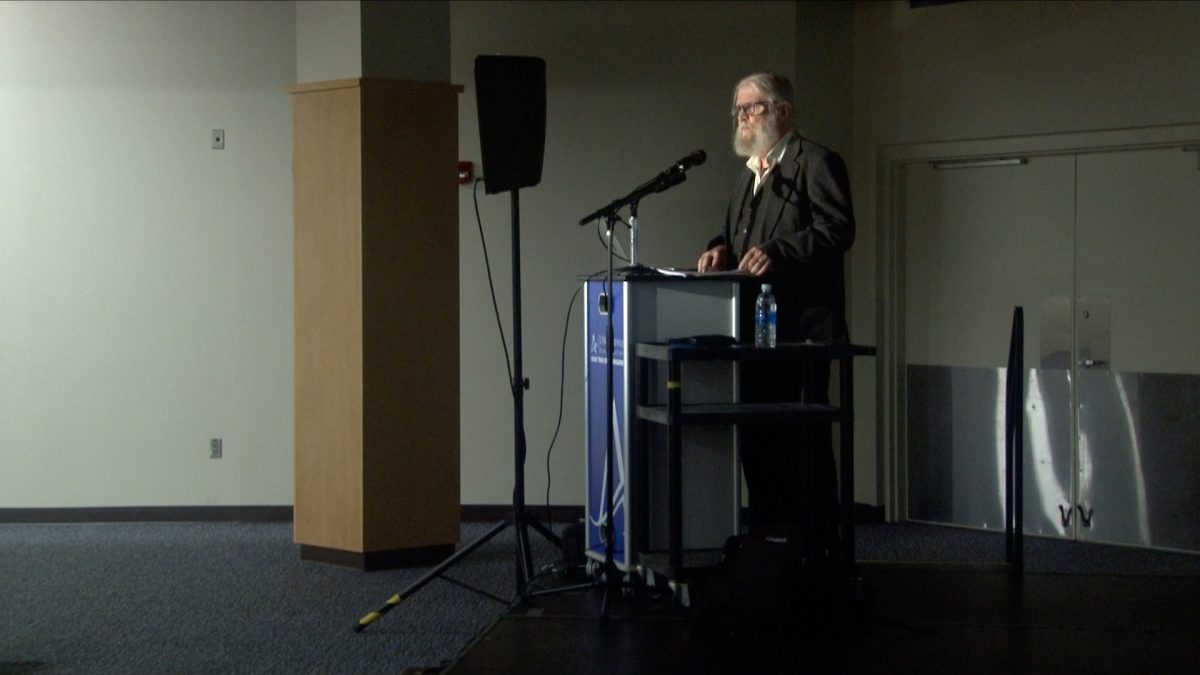The duke’s extended stay in Asheville

Buncombe County Special Collections library
An illustration of Lascelles socializing from old newspaper clippings found in the Buncombe County Special Collections library.
October 21, 2022
The train rolled into Asheville on crisp fall morning in 1902 as the frost dissipated from the mountain tops under the morning sun and out stepped a man. An apparently wealthy man dressed as a respected English man in a well-pressed suit, bowler hat and well-trimmed beard. The mysterious man was accompanied by a nurse who he had hired and knew very little about him.
Seeking treatment for his persistent cough in the highly regarded tuberculous healing hub known as Asheville or “The Land of the Sky.” According to the Swannanoa Valley Museum and History Center, Asheville and surrounding areas were of the most popular treatment areas for tuberculosis due to the high altitude and climate, it was thought that the fresh air would help heal patients.
The thin, frail man who appeared in Asheville was taken to one of the many sanitaria houses on Montford Avenue, registering under the name of Mr. Charles J. Asquith. Rumors spread throughout the healing town that a man connected to the English nobility was residing here and thought to be a man of great wealth.
Asquith’s time living in Asheville was short-lived but his stay in the city was quite the opposite. After his death it was discovered, he had only $5 to his name and he was sent to a local mortician. Word of his death was sent to England in hopes of notifying his family, but no one claimed to know the man.
Asquith’s body was given to a local mortician, Claude Holder, at Noland-Brown Funeral home on Church Street. With no one having any knowledge of a man under this name traveling to the Americas, the mayor of Asheville had the funeral home embalm the body until someone claimed him and paid his overhanging medical bills.
As time passed and no one to show forth to account for Asquith’s body, the funeral home decided to use his body to market their embalming services. Asquith’s body was often loaded onto the back of a horse trailer and paraded around the streets of Asheville and then later returned to his coffin where he stayed until his next showing.
As years went by and Asquith’s corpse made a name around Pack Square, many began referring to his lifeless body as the duke. The duke was also displayed in the glass case in front of the funeral home, yet another marketing ploy for the funeral home.
The duke also became an inactive participant in part of Noland-Brown Funeral Home’s new hire practice. One man was sent to go talk to the boss upstairs and was told “He doesn’t talk much”, to the eager new hire’s horror, the boss did not have anything to say at all.
The duke also always had a seat reserved at the poker table on the top floor of the funeral home. On one evening a few men gathered around to play a game of poker and one jokingly commented that if he had a poker face as good as the duke’s, he might actually win a game or two.
After nearly seven years passed, a woman heard word of the man being kept in Asheville awaiting a familiar face. Mrs. Summerfield’s supposed sister-in-law of the duke came to claim his corpse on behalf of his wife, who allegedly lived in Baltimore.
Summerfield said that Asquith was not the man’s real name and the man that paraded the streets of Asheville was Sidney Lascelles, who also has gone by the name of Lord Beresford.
The once rumored wealthy duke quickly became denounced as a poor conman by the name of Lascelles with a past filled with gambling, womanizing and losing large amounts of money. The supposed sister-in-law paid his debts, signed the affidavit and loaded the corpse into the same train car he stepped out of seven years ago to be cremated in Washington.
Several townspeople gathered as the barriers ushered the duke onto the train to await his new fate.
Time passed and curiosity arose so in efforts to ensure the duke was cremated in Washington, authorities reached out to Dr. McPherson Crichton, the doctor that Summerfield had said would cremate the body. Crichton said at the time that he had not seen the duke or Summerfield and no corpse under the name of Lascelles had been cremated by him.
Upon further investigation, Crichton had been under strict guidance to deny any questions about Lascelles or Summerfield. But Crichton later admitted to cremating the body of Lascelles, commenting that the Lascelles was the most life-like corpse he had ever seen.
Out of embarrassment of Lascelles’s scandalous tendencies, Summerfield was Lascelles’s wife. Not his sister-in-law, but was reluctant to claim him as her husband due to his womanizing and conman history.
Despite the eventful occurrences that happened after Lascelles’s death, his time spent living was almost equally eventful.
Lascelles was a social favorite of half a dozen countries. He was an Australian native but spent most of his life in northern England. He worked at a conservative banking house in London, but lost his position due to his propensity for horse racing and gambling.
Despite not having a job or money at the time, Lascelles was still a respectable man and used his influential friends to write him a letter of recommendation to work in India. He set out to India in hopes of reaping fortune and went by the name Walter Beresford.
To no avail, Lascelles did not stumble upon the fortunes he was hoping for and received word that his father passed away, so he packed his bags and headed back to London. After the funeral and affairs were in order, Lascelles grew antsy and tired of the society lifestyle that followed him around London. He packed his bags and headed to India once more determined to make something of himself.
While on an adventure in a river, Lascelles found himself tangled in a dance with death. In order to save his own life, he had to shoot a guide named Hassan. Hassan apparently had a lot of connections with a certain group of people who knew of a dangerous Burmese poison that brought on a slow lingering death.
Lascelles, with the help of friends among local officials, escaped being persecuted for the death of Hassan and was warned to leave the country immediately due to Hassan’s involvement with the group that had their hands on a deadly poison.
Lascelles arrived back to his room after promising officials that he would leave at once. To his surprise, a young girl dropped off a package for him while he was away and inside laid a valuable small teakwood casket that was finely carved and lined with silk. Lascelles had a knack for valuable collectibles and acted upon his intrigue to find the girl who left him this mysterious gift. To no avail, the girl was never found, and Lascelles made arrangements to return to England.
Back at the place he started, empty-handed, broke and with nothing to show for his travels other than his small wooden casket, Lascelles was caught in a spell of bad luck. Word began to travel around England that the once highly regarded banker had lost all his money. Social clubs that once accepted him with open arms turned a cold shoulder and Lascelles was left in the shadow of the man he once was.
With nowhere else to turn, Lascelles sailed to the United States in hopes of a prosperous future, where no one knew about his troubling past. On the ship he met a lady from New York, who went by the name Maude Leslie. Lascelles couldn’t turn down his infatuation with a pretty woman and struck up a conversation with her. He fell madly in love with her, and they became engaged in February of 1891 and Miss Leslie became Mrs. Sidney Lascelles.
The two made a trip to Atlanta to cash a few of Lascelles’s checks. During this time, he went by the name Lord Beresford and was received as royalty. He received his money and they headed back to their home in New York. A short while went by and the checks began returning as fraudulent and Lascelles was arrested in New York and taken to Atlanta. In Atlanta he was sentenced to six years at a prison camp where he worked at a lumber mill in Kramer, Georgia.
Lascelles had an exemplary work ethic during his time at the lumber mill and by the time he was released he was given a great deal of authority in management. He used this experience to start a business adventure in Fitzgerald, Georgia. He was regarded as one of the most popular men in the town, but Lascelles has a way with turning his strike of good luck and honest work upside down. His scheming past caught up with him once again and Lascelles disappeared in the middle of the night.
Lascelles had three more adventures up his sleeve before he fell ill. The first was in Texas, where he manipulated oil stock and after he had his fill he disappeared into the night once more. The second was in the Alaskan Yukon where he reaped a rich harvest from a few reckless miners, then gone without a trace into the night. The third was in California, where he sold fraudulent bonds. This time he was not able to escape in the night but landed himself in prison for the second time.
All of Lascelles’s adventures seemed to be met with a sense of urgency and the need to make quick money and disappear. Some think the death of the guide and the looming threat of the Burmese poison weighed on him and accounted for his tendency to rush through life’s escapades.
After being released from the California prison Lascelles fell ill and went to the only place he thought could heal him, Asheville, North Carolina. Lascelles was in the care of one of the top physicians in Asheville, Dr. J.A. Burrough.
Those who surrounded Lascelles in his final days described his condition as a lingering, withering death that slowly drained the vitality from the flesh.
After Lascelles passed the teakwood casket he carried with him throughout all his travels was nowhere to be found.
The cause of death for Lascelles was not attributed to any one thing. Some thought tuberculosis might be the cause of death, due to the outbreak at the time, but others think he was poisoned in India and that brought on his slow lingering death.

















